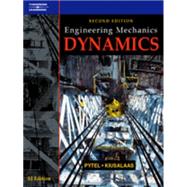
Note: Supplemental materials are not guaranteed with Rental or Used book purchases.
Purchase Benefits
Looking to rent a book? Rent Engineering Mechanics : Dynamics [ISBN: 9781861526182] for the semester, quarter, and short term or search our site for other textbooks by Pytel, Andrew. Renting a textbook can save you up to 90% from the cost of buying.
| Introduction to dynamics Introduction | |
| Derivatives of Vector Functions | |
| Position, Velocity, and Acceleration of a Particle | |
| Newtonian Mechanics | |
| Dynamics of a particle: rectangular coordinates Introduction | |
| Kinematics | |
| Kinematics: Force-Mass-Acceleration Method | |
| Dynamics of Rectilinear Motion | |
| Superposition of Rectilinear Motions | |
| Motion Diagrams by the Area Method | |
| Numerical Integration of a Second-Order Differential Equation | |
| Numerical Integration of Coupled Second-Order Differential Equations | |
| Dynamics of a particle: curvilinear coordinates Introduction | |
| Kinematics - Path (Normal-Tangential) Coordinates | |
| Kinematics - Polar and Cylindrical Coordinates | |
| Kinetics: Force-Mass-Acceleration Method | |
| Numerical Integration: Curvilinear Coordinates | |
| Work-energy and impulse-momentum principle for a particle Introduction | |
| Work of a Force | |
| Principle of Work and Kinetic Energy | |
| Conservative Force and the Conservation of Mechanical Energy | |
| Power and Efficiency | |
| Principle of Impulse and Momentum | |
| Principle of Angular Impulse and Momentum | |
| Space Motion under a Gravitational Force | |
| Dynamics of particle systems Introduction | |
| Kinematics of Relative Motion | |
| Kinematics of Constrained Motion | |
| Kinetics: Force-Mass-Acceleration Method | |
| Work-Energy Principles | |
| Principle of Impulse and Momentum | |
| Principle of Angular Impulse and Momentum | |
| Plastic Impact | |
| Impulsive Motion | |
| Elastic Impact | |
| Mass Flow | |
| Planar kinematics of rigid bodies Introduction | |
| Plane Angular Motion | |
| Rotation about a Fixed Axis | |
| Relative Motion of Two Points in a Rigid Body | |
| Method of Relative Velocity | |
| Instant Center for Velocities | |
| Method of Relative Acceleration | |
| Absolute and Relative Derivatives of Vectors | |
| Motion Relative to a Rotating Reference Frame | |
| Method of Constraints | |
| Planar kinetics of rigid bodies: force-mass-acceleration method Introduction | |
| Mass Moment of Inertia | |
| Composite Bodies | |
| Angular Momentum of a Rigid Body | |
| Equations of Plane Motion | |
| Force-Mass-Acceleration Method: Plane Motion | |
| Differential Equations of Motion | |
| Planar kinetics of rigid bodies: work-energy and impulse-momentum methods | |
| Work-Energy Method | |
| Introduction | |
| Work and Power of a Couple | |
| Kinetic Energy of a Rigid Body | |
| Work-Energy Principle and Conservation of Mechanical Energy | |
| Impulse-Momentum Method | |
| Momentum Diagrams | |
| Impulse-Momentum Principles | |
| Rigid-Body Impact | |
| Rigid-body dynamics in three dimensions Introduction | |
| Kinematics | |
| Impulse-Momentum Method | |
| Work-Energy Method | |
| Force-Mass-Acceleration Method | |
| Motion of an Axisymmetric Body | |
| Vibrations Introduction | |
| Undamped Free Vibrations of Particles | |
| Undamped Forced Vibrations of Particles | |
| Damped Free Vibrations of Particles | |
| Rigid-Body Vibrations | |
| Energy Method and Rayleigh's Method | |
| Appendices | |
| D. Proof of the relative velocity equation for rigid-body motion | |
| E. Numerical differentiation | |
| Introduction | |
| Central Difference Formulas with Error of Order (delta x) Squared | |
| F. Mass moments and products of inertia | |
| Introduction | |
| Review of Mass Moment of Inertia | |
| Moments of Inertia of Thin Plates | |
| Mass Moment of Inertia by Integration | |
| Mass Products of Inertia | |
| Parallel-Axis The orems | |
| Products of Inertia by Integration | |
| Thin Plates | |
| Inertia Tensor | |
| Moment of Inertia about an Arbitrary Axis | |
| Principle Moments and Principle Axes of Inertia | |
| Answers | |
| Index | |
| Table of Contents provided by Publisher. All Rights Reserved. |
The New copy of this book will include any supplemental materials advertised. Please check the title of the book to determine if it should include any access cards, study guides, lab manuals, CDs, etc.
The Used, Rental and eBook copies of this book are not guaranteed to include any supplemental materials. Typically, only the book itself is included. This is true even if the title states it includes any access cards, study guides, lab manuals, CDs, etc.